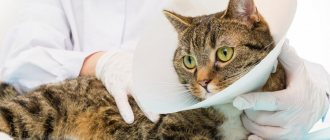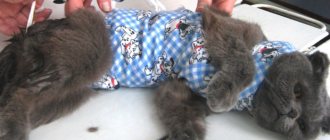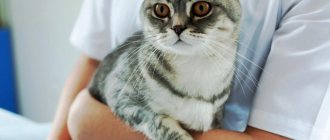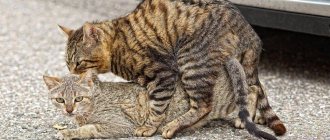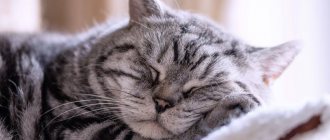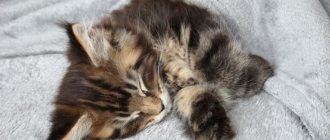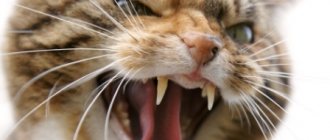Castration of a cat is a fairly simple surgical operation in which the gonads (testes) of a mustachioed pet are removed. The purpose of the operation is to correct behavior, suppress sexual instincts, and deprive males of reproductive function. Castration is carried out under anesthesia, does not take much time, and with proper care, cats do not experience any serious complications. How is this operation performed? What is proper care during the postoperative period? How long does it take for a cat to recover from anesthesia after castration? You will find answers to these questions in this article.
Castration of cats
Castration of a cat is one of the simplest, fastest, and most uncomplicated surgical operations. During surgery, general anesthesia is used for pain relief. Some veterinarians practice combined anesthesia (general, local), using short-acting drugs that reduce the sensitivity of animals for a certain period. In addition to injection drugs, special gas and ethers are used.
After administering the drugs, it takes some time for the cat to fall asleep. Time intervals depend on the individual physiological parameters of the mustachioed pets’ body.
The anesthesia drug and dosage are selected by the veterinarian taking into account the individual characteristics of the body, age, and weight of your cat.
After the injection, before putting the cat into a narcotic sleep, the pet may feel sick and vomit. This is normal. This is how the animal’s body reacts to the administration of the drug. Therefore, before castration, veterinarians recommend keeping your pet on a starvation diet .
Before the operation, the surgeon examines the animal, measures the temperature, heart rate, and determines the cat’s weight. Castration is carried out only if there are no contraindications and all vital signs are normal. The duration of castration ranges from 15-20 minutes to an hour. During the operation, the veterinarian surgeon makes thin incisions and through them removes the testes that produce sex hormones.
What signs should alert the owner
In the vast majority of cases, castration of a cat takes place without any consequences. However, it is worth remembering three very dangerous symptoms that should alert you:
- increased body temperature on the third day after surgery;
- lack of appetite in the first three days after surgery;
- the presence of inflammation, slight bleeding or discharge from the sutures.
All these signs may indicate a developing complication, which only an experienced specialist can identify and provide qualified assistance.
How long does it take for cats to recover from anesthesia after surgery?
It is quite difficult to answer the question unequivocally: “How long does it take for a cat to come to his senses after castration and recover from anesthesia?” However, the consequences of anesthesia for the animal can be unpleasant. If the dosage is chosen incorrectly, in case of hypersensitivity to the components of the drugs, anesthetic shock may develop.
The time it takes for cats to recover from anesthesia depends on:
- on the type of anesthesia used;
- dosage of the drug, depth of anesthesia;
- age, body weight;
- conditions, such as the nervous system.
How long it takes for a cat to fully recover depends largely on the individual characteristics of the body and age. For example, adult, old cats take longer to recover from anesthesia than young pets. Energetic, temperamental pets, cats with an excitable nervous system also recover quite quickly after injection anesthesia. Phlegmatic animals and pussies of a calm disposition can sleep for a day after anesthesia.
Note that if combined anesthesia, special gas, or any other modern techniques were used to induce narcotic sleep, the recovery period after anesthesia will be minimal. With general anesthesia, the cat remains under the influence of sedatives and muscle relaxants for three to twelve hours.
With deep anesthesia, postoperative sleep can last up to six to eight hours.
Effect of anesthesia and surgery
Spaying and neutering surgery is usually performed under general anesthesia. Sometimes a substance is used that simply desensitizes the animal.
The operation itself lasts 10-20 minutes, but when administering anesthesia it is necessary to wait for the cat to fall asleep (10-30 minutes). An injection with a special drug is given intravenously or intramuscularly. The duration of anesthesia and rehabilitation depends on the individual characteristics of the body.
The dose of the substance is determined by the weight and age of the cat. The older the cat, the longer it takes to recover from anesthesia after castration. During the operation, the surgeon uses small, neat incisions to remove the testicles, which contain glands that secrete sex hormones.
After the operation, cats no longer feel attracted to the opposite sex. They have no feelings of inferiority. They become more affectionate, active, and inquisitive about the world around them. Neutered animals live longer.
An incision is made on the cat's stomach. Its length depends on the type of operation and the size of the animal. The length of the wound can reach 3 cm. There are new surgical methods in which the incision can be 1 cm in size. In this case, you should not wear a blanket, since the wound is small and can heal on its own.
To prevent your cat from vomiting during anesthesia, it is recommended not to feed the animal on the eve of surgery.
Complications after anesthesia
After operations using general anesthesia, in some cases, veterinarians recommend leaving the cat in the clinic for a while to monitor the animal’s condition. In case of possible complications, the surgeon who performed the operation will provide qualified assistance.
Possible complications after anesthesia and castration:
- heartbeat disturbance;
- depression of the respiratory center;
- a sharp drop in overall temperature;
- muscle cramps, spasms;
- disorientation in space;
- inappropriate behavior;
- bleeding of postoperative sutures.
If the veterinarian deems it necessary, he will advise leaving the cat in the clinic for several days until the animal’s condition is completely normalized.
Therefore, we recommend leaving the veterinary clinic after castration or performing any other surgical operations only when the veterinarian says so and no complications are observed. Be sure to ask your veterinarian about how long it will take for your cat to recover from anesthesia, as well as how to properly care for your pet during the postoperative period.
Recovery of a cat from anesthesia
When a cat is under general anesthesia, its eyes remain open. The risk of corneal drying increases. Bright light can damage the sensitive retina. This feature of cat physiology must be taken into account.
Before surgery, it is recommended to drip a moisturizing ophthalmic solution into your pet's eyes. The drops will prevent the cornea from drying out. During recovery from anesthesia, it is necessary to press the cat's upper and lower eyelids together with your fingers every half hour. The procedure is repeated until the blink reflex is restored.
Neutering a cat affects thermoregulation. Body temperature may rise as the body fights the effects of anesthesia. To prevent the oral cavity from drying out, it is necessary to forcefully feed the animal with a pipette or syringe without a needle. In this case, it is better to use filtered or boiled water rather than tap water.
How does a cat behave after anesthesia?
As a rule, if there are no contraindications and complications have not developed, you can take your cat home after surgery in about 30-40 minutes. As already noted, after anesthesia, the cat can sleep for some time and this time range varies and is individual for each animal. Even if the veterinarian assures that after anesthesia the cat will recover in a maximum of three to four hours, this is not always the case. The pet can lie down without moving for five or even eight to ten hours. Just carefully monitor the condition and behavior of your furry pet on the first day after surgery .
While the cat is in a narcotic sleep, you need to close the pet's eyelids to prevent dry sclera. Unlike humans, after the administration of anesthetics, a cat's eyes can be completely open during surgery. To prevent the sclera from drying out, during castration the surgeon closes the animal’s eyelids.
After surgery, this effect of anesthesia continues, so keep an eye on your furry pet's eyes. But if the veterinarian brought the cat out of anesthesia, you don’t have to do this. The animal will gradually withdraw from the effects of the medications, remaining conscious.
In the first hours after castration, the cat may feel sick. The vomit contains bile, mucus, and foam. In addition to foamy vomiting, you may notice spastic convulsions and profuse salivation.
After the operation the cat will be weakened. Movement coordination is impaired. The pet may become completely disorientated in space, react inadequately or very weakly to external stimuli, move with a staggering gait, bump into various objects, and may defecate in the wrong place.
Unconsciously, the cat will try to climb to a height, for example, onto a chair, sofa, bed, play set, but due to poor coordination of movement, the pet, falling from a height, can be seriously injured.
Spontaneous urination is possible . In this case, urine has a sharp specific odor due to hormone residues.
Within three to six hours, the cat feels weak in the muscles and dizzy. Make sure that he does not climb onto furniture, a sofa, or jump from a height. Therefore, provide your pet with a comfortable bed on the floor.
On the first day after castration, a decrease in temperature by 0.5-1 degrees is often noted. The cat may have a fever and chills. To warm your pet, cover it with a warm wool blanket, blanket, and place a heating pad or a plastic bottle with warm water. Lubricate the cat's paws to normalize blood flow. At the same time, constantly monitor your body temperature until it normalizes. Hypothermia and overheating of the pet should not be allowed.
After castration, the cat will most likely have no appetite. Possible disruption of digestive processes (unstable stool, diarrhea). Never force feed your pet, especially if the cat is vomiting. But provide free access to drinking water. A cat may feel thirsty after anesthesia. Feed your pet after castration only when the cat asks for food.
As a rule, already on the second day after castration, cats with proper care feel much more energetic. Most importantly, do not leave your pet alone. One of your family members or friends should monitor the cat's condition in the first 24-48 hours.
When to sound the alarm
To make recovery from anesthesia as smooth and comfortable as possible, provide all the necessary conditions. Also constantly monitor the condition of the animal:
- Measure your body temperature every two hours;
- Listen to the heart rhythm: there should be no pauses or sudden jumps in the heartbeat;
- Take care of your cat's eyes and inspect the mucous membranes of the mouth;
- If an external suture remains after surgery, treat it regularly;
- Follow all doctor's instructions (injections, wound treatment).
There are situations when the animal's condition worsens. In this case, you cannot hesitate.
Feel free to contact the doctor at any time of the day if something is wrong with your cat.
You should call your doctor immediately if you have the following symptoms:
- Respiratory disturbance: the cat wheezes, breathes shallowly, inhales are intermittent or shallow;
- The mucous membranes have changed color: they have turned red or blue, excessively pale;
- The pulse is difficult to hear or interruptions are heard;
- Body temperature has increased or decreased;
- The time allotted for awakening has passed, and the cat does not respond to touching its whiskers and nose;
- Any symptoms that seem unacceptable to the owner.
Caring for cats after castration
Be sure to ask your veterinarian surgeon about how to properly care for a castrated cat during the postoperative period. The length of the rehabilitation period depends on proper care. It is very important to prevent possible complications after castration.
First of all, provide the cat with maximum peace, favorable conditions, and protect him from stress. Constantly monitor the animal's condition. Keep a veterinary kit on hand to provide timely assistance in emergency situations.
After castration, after recovering from anesthesia, in the first days the cat will constantly try to lick the wounds and chew the stitches. You should absolutely not allow your pet to do this. An infection or pathogenic flora can get into an open wound, which can cause the development of acute inflammation and swelling. Therefore, we recommend putting a special protective collar on the cat for 5-7 days, which can be purchased at the clinic. where the operation was performed, in a pet store or veterinary pharmacy.
When choosing a protective accessory, consider the type of design, size, and quality parameters of the material.
The collar should not cause discomfort to the cat or restrict movement. You can remove it during feeding or for a few minutes a day without leaving the cat unattended. The protective structure can be completely removed after the stitches have been removed and the wounds have healed.
Monitor the cat's movements during the first two days. The cat should not jump to heights or be too active. The seams may come apart. Make sure that the cat does not stay in a draft or near heating devices.
Examine postoperative wounds several times a day. To treat them, use antiseptics prescribed by your veterinarian (furacilin, hydrogen peroxide, chlorhexidine). Use anti-inflammatory, wound-healing ointments, gels, linements to accelerate tissue regeneration. Seams can also be treated with brilliant green, silver nitrate (aerosol, silver).
Advice! If you don't have a collar at hand, you can put a baby diaper on your pet by making a hole for the tail. Replace the diaper after each treatment.
You should feed your cat after surgery only when the pet shows interest in food. Food should be easily digestible and nutritious on the first day. You can feed your cat low-fat boiled chicken, turkey, and rabbit. Water must be freely available. On the third day, introduce yogurt and fermented milk products into your diet.
If the cat is kept on ready-made commercial food, purchase “premium” or “super-premium” class products marked “For castrated animals.” Similar foods are available in the product lines of many manufacturers (Acana, Hills, Royal Canin, NM). Consider the age of the pet.
After castration, you will have to review and adjust the pet's diet . Properly selected nutrition will help avoid overfeeding, obesity, and endocrine pathologies.
It is also worth noting that after castration, the behavior of a neutered cat may change. Be patient. After a few weeks or months, the pet’s condition is completely normalized.
Possible complications and warning signs
There is always a risk of complications, so be vigilant and notice any changes. Immediately after surgery, it is recommended to monitor the heartbeat, temperature and appearance of the mucous membranes. You should contact your veterinarian if:
- blue or pale mucous membranes;
- prolonged decrease or increase in temperature;
- fast or slow heart rate;
- refusal to eat for more than 2 days (for a kitten – strictly for a day);
- severe nausea (the cat vomits even on an empty stomach);
- persistence of swelling and redness on the wound for more than 3 days;
- the appearance of a hernia - a small compaction under the skin;
- shallow breathing and wheezing.
Also, a visit to the veterinary clinic will be required if a drowsy and apathetic state persists for more than a day. In this situation, it is better to play it safe to prevent more serious complications.
In most cases, the danger of anesthesia is greatly exaggerated. Subject to medical recommendations, taking into account contraindications and preliminary examination, furry pets can undergo surgery under general anesthesia without consequences.
How long does it take?
How long it takes for an animal to wake up depends on its age and body characteristics. Typically, recovery from anesthesia is observed four hours after surgery. According to experienced breeders, pets that are very active wake up earlier. Already 60 minutes after castration they begin to get up or try to climb onto the bed. On animals that have a phlegmatic temperament, anesthesia lasts longer. The pet often wakes up after 6 hours, but the effect of anesthesia sometimes lasts up to 24 hours.
What is anesthetic risk?
No matter how experienced the surgeon and anesthesiologist are, there is always the possibility of complications, even death. Anesthesia for cats is a serious burden primarily on the cardiovascular and respiratory systems. Minimizing anesthetic risks is the task of the veterinarian, who is obliged to individualize the standard regimen taking into account the characteristics of a particular cat. In many cases, the serious condition of a cat after anesthesia is a consequence of the use of drugs “at random”, without studying the condition of the mustachioed patient. To avoid problems, it is important to contact only competent specialists with an excellent reputation.
